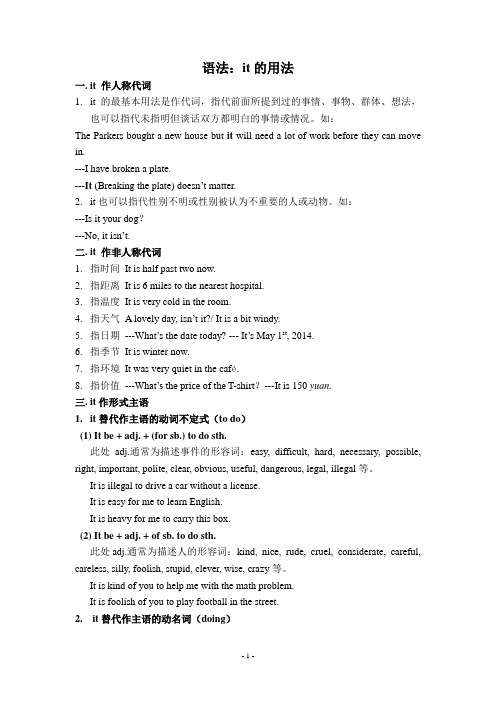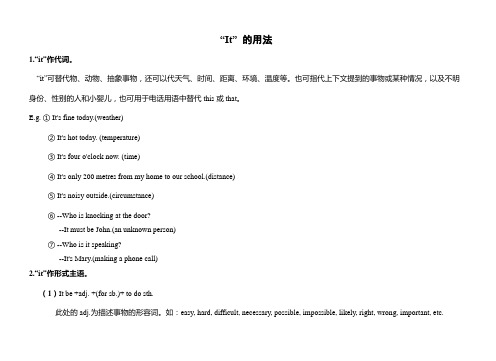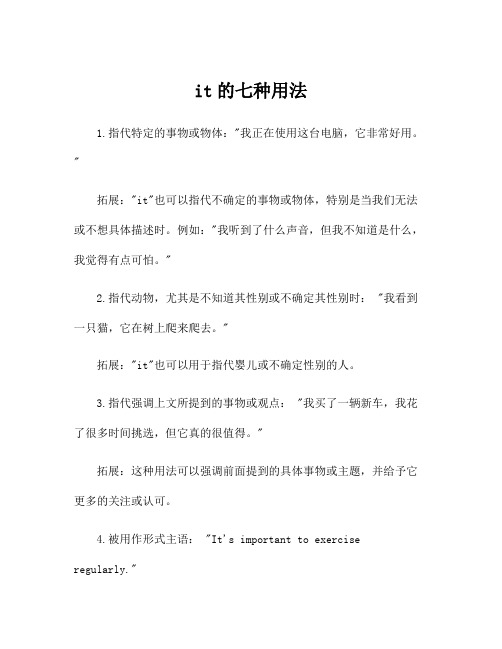it的用法总结
it的用法

语法:it的用法一.it 作人称代词1.it的最基本用法是作代词,指代前面所提到过的事情、事物、群体、想法,也可以指代未指明但谈话双方都明白的事情或情况。
如:The Parkers bought a new house but it will need a lot of work before they can move in.---I have broken a plate.---It (Breaking the plate) doesn’t matter.2.it也可以指代性别不明或性别被认为不重要的人或动物。
如:---Is it your dog?---No, it isn’t.二.it 作非人称代词1.指时间It is half past two now.2.指距离It is 6 miles to the nearest hospital.3.指温度It is very cold in the room.4.指天气A lovely day, isn’t it?/ It is a bit windy.5.指日期---What’s the date today? --- It’s May 1st, 2014.6.指季节It is winter now.7.指环境It was very quiet in the café.8.指价值---What’s the price of the T-shirt?---It is 150 yuan.三.it作形式主语1.it替代作主语的动词不定式(to do)(1) It be + adj. + (for sb.) to do sth.此处adj.通常为描述事件的形容词:easy, difficult, hard, necessary, possible, right, important, polite, clear, obvious, useful, dangerous, legal, illegal等。
It的用法

“It” 的用法1.“it”作代词。
“it”可替代物、动物、抽象事物,还可以代天气、时间、距离、环境、温度等。
也可指代上下文提到的事物或某种情况,以及不明身份、性别的人和小婴儿,也可用于电话用语中替代this或that。
E.g. ① It's fine today.(weather)② It's hot today. (temperature)③ It's four o'clock now. (time)④ It's only 200 metres from my home to our school.(distance)⑤ It's noisy outside.(circumstance)⑥ --Who is knocking at the door?--It must be John.(an unknown person)⑦ --Who is it speaking?--It's Mary.(making a phone call)2.“it”作形式主语。
(1)It be +adj. +(for sb.)+ to do sth.此处的adj.为描述事物的形容词。
如:easy, hard, difficult, necessary, possible, impossible, likely, right, wrong, important, etc.E.g. ① It's easy for us to climb the hill.② It's difficult for me to work out the maths problem.(2) It be +adj.+(of sb.)+to do sth.此处的adj.为描述人的形容词。
如:kind, nice, rude, cruel, careful, careless, silly, foolish, stupid, wise, crazy, etc.E.g. ① It's kind of you to help me with this problem.② It's foolish of you to believe in such a person.③ It's wise of you to choose to study abroad.(3). It be + adj.+ doing sth.It's no good/use doing sth.It's (well) worth doing.E.g. ① It's no good arguing with him.② It's no use crying over spilt milk.③ It's no good drinking too much wine.(4) It be +adj./n. +Clause.It's a pity that…It's a fact that…(It's) no wonder that…It's obvious that…It's certain that…It's strange/important/necessary that…(要用虚拟语气)(用should+动词原形)It worries/surprises sb. that…It seems/appears that…It turned out that…It (suddenly) occurred to sb. that…It strikes/struck sb. that…It's said/reported/believed… that…It doesn't matter whether…It makes no di fference whether…(5)其它句型。
it的用法归纳

it的用法归纳
1. 代词:it可以代替前面出现过的事物、物品、动物等,做主语、
宾语、表语等。
例句:I saw a bird in the tree. It was singing beautifully. (我看见了一只鸟在树上。
它唱得很美。
)。
2. 指示代词:it也可以作为指示代词,用来指代某一事物或物品。
例句:I want this book, not that one. Give me it.(我想要这
本书,不是那本。
给我它。
)。
3. 不定式:it可以作为不定式的形式,表示“它”的含义,一般表
示时间、天气等。
例句:It’s nice to see you again.(很高兴再次见到你。
)。
4. 表示真理或存在:it可以用来表示某件事或事物的存在或真相。
5. 表示强调:it可以作为强调句的主语,强调句子中重要的信息。
例句:It was him who broke the vase, not me.(是他打破了花瓶,不是我。
)。
6. 虚主语:it可以作为虚主语出现在句首,表示无人称、无性别的
动作或状态。
代词it的用法

代词it的用法
1. “It”可以用来指代天气呀!比如说:“It's really sunny today.”
哎呀,想想当你抬头看着那湛蓝的天空和灿烂的阳光,说这句话的时候是不是感觉心情都超好呢!
2. 你知道吗,当我们想指代某件事情的时候,也会用到“it”呢!就像“Making a handmade gift for her is a great idea. It will make her very happy.”这里的“it”就是指做手工礼物这件事呀,难道不是很有趣吗?
3. 当我们谈论时间的时候,“it”也大显身手啦!像“Look at the time!
It's getting late.”天哪,看到时间流逝,说这句话时是不是会有点小紧张呢!
4. “It”还能指代某个动物或物品呢。
“I love my dog. It is so cute.”看
到可爱的狗狗,用“it”来指代它,是不是感觉特别亲切呀!
5. 有时候我们也会用“it”来表示一个情境或局面哟!比如“Things are getting complicated. It's not that easy.”哇,面对复杂的情况,说出这
句话是不是很有感慨呢!
6. 想象一下,我们在描述距离的时候也能用“it”呢!“The distance between us is not that far. It can be easily covered.”哎呀,想到能跨越那不远的距离,是不是有点小期待呢!
我觉得“it”的用法真是丰富又有趣,在我们日常交流中起到了很重要的作用呢!。
(完整版)It的用法总结

It的用法总结在英语中,it有许多不同的用法,它既可以用作代词(如人称代词、非人称代词),也可以用作引导词(作形式主语或形式宾语),还可以用来构成强调句型。
.it用作代词(1) 用作人称代词在句子中作主语或宾语;指前面已经提到过的事物、动物或人,且it指特定的事物;如果指前文中提到的事物中的任何一个,用one。
one可以与any, each, every, not等连用,但one不可代替不可数名词。
—where’s your car?—it’s in the garage. 你的汽车在哪儿呢?在车库里。
(指代物品your car)did you hit it? 你打中了吗? (指代事件)the baby cried when it was hungry.这婴儿饿时就哭。
(指代婴儿,尤指性别不详或无所谓时)—who is that?—it’s me. 是谁?我。
(指一定情景中所确定的人或事物,此时相当于指示代词,代指this和that,有时也指人)—what’s this?—it’s a box. 这是什么?一只箱子。
(2) 作非人称代词表示天气、日期、时间、温度、距离、价值、路程、度量、自然现象与环境等。
也可模糊地指一般情形或上文的部分或整个意思。
译成汉语时,it通常不一定译出来。
it’s a long time since they left. 他们走后很久了。
it’s two miles to the beach.离海滨有两英里远。
that’s just it—i can’t work when you’re making so much noise.原因就在这里——你弄出这么大的声音,我工作不了。
另外,需要注意两点:(1)“it’s time…”后面可以接不定式和介词短语表示“是做……的时候了”。
如:it’s time for supper. it’s time to have supper.(2) “it’s time…”后面还可以接一个从句,但是从句中的谓语动词一定要用过去式即虚拟语气,如:it’s time we had lunch.是我们吃饭的时候了。
it的七种用法

it的七种用法1.指代特定的事物或物体:"我正在使用这台电脑,它非常好用。
"拓展:"it"也可以指代不确定的事物或物体,特别是当我们无法或不想具体描述时。
例如:"我听到了什么声音,但我不知道是什么,我觉得有点可怕。
"2.指代动物,尤其是不知道其性别或不确定其性别时: "我看到一只猫,它在树上爬来爬去。
"拓展:"it"也可以用于指代婴儿或不确定性别的人。
3.指代强调上文所提到的事物或观点: "我买了一辆新车,我花了很多时间挑选,但它真的很值得。
"拓展:这种用法可以强调前面提到的具体事物或主题,并给予它更多的关注或认可。
4.被用作形式主语: "It's important to exercise regularly."拓展:在某些句子中,"it"可以用作形式主语,代表主语部分的内容,尤其是当真正的主语是以后出现时。
5.引导强调句: "It was John who broke the vase."拓展:在强调句中,"it"被用作形式主语,而真正的主语将被放置在句子的后部,以便强调。
6.用于指示时间、天气和环境条件: "It's raining outside."拓展:"it"在描述天气、时间或条件时,常用于英语中,例如:"It's getting late." "It's hot today."7.在某些习语中,表示状态或情感: "I'm over it." (我已经度过了这个困境)拓展:在某些习语或俚语中,"it"用于表示情感、状态或体验,并在一定程度上代表所描述的特定情况。
it的七种用法
"IT" 这个缩写有多种用法,以下是其中七种常见的用法:
1. 信息技术(Information Technology):这是最常见的用法,指的是利用计算机和通信技术来处理、存储、传输和管理信息的领域。
2. 互联网技术(Internet Technology):这是指与互联网相关的技术,包括网页设计、网络编程、网络安全等。
3. 信息技术产业(Information Technology Industry):这是指生产和销售信息技术产品和服务的行业,包括计算机硬件、软件、通信设备等。
4. 信息技术部门(Information Technology Department):这是指企业或组织内部负责管理和维护信息技术系统的部门。
5. 信息技术专业(Information Technology Major):这是指大学或学院中培养信息技术人才的专业,包括计算机科学、信息管理等。
6. 信息技术服务(Information Technology Services):这是指提供信息技术支持和维护服务的公司或组织,包括网络管理、数据备份等。
7. 个人信息技术(Personal Information Technology):这是指个人使用的信息技术设备和应用,包括智能手机、平板电脑、个人电脑等。
以上是 "IT" 的七种常见用法,当然还有其他一些不太常见的用法。
人称代词it的用法总结
人称代词it的用法总结人称代词在英语中起着非常重要的作用,它们可以替代特定的名词或名词短语,以避免过多重复。
其中一个常见的人称代词就是"it"。
下面将详细总结"it"在不同情况下的用法。
一、指示事物或物体1. 指代单数名词:当我们第一次提到某个具体事物或物体时,可以使用"it"来指代。
例如:- Look at the beautiful flower! It is in full bloom.- The new car is expensive, but it's worth every penny.2. 指代抽象事物:当我们谈论关于天气、环境或其他抽象概念时,也可以使用"it"来指代。
例如:- It is raining heavily today.- It seems that there will be a storm tonight.3. 表示距离或方位:当我们谈论远处或方向时,常使用"it"来表示。
例如:- I can see the lake from here. It looks beautiful.- Turn left at the next intersection. It's just around the corner.二、指示时间和日期1. 表示时间:当我们描述时间时,可以使用人称代词"it"。
例如:- Is it already 10 o'clock? We need to hurry.- It's late, we should go home now.2. 指示日期:当我们谈论某个具体的日期时,也可以使用"it"。
例如:- I have an important meeting on Friday. It's going to be a long day.- The party is on Saturday night. It starts at 8 o'clock, so don't be late.三、指代动物和婴儿1. 指代动物:当我们不知道或不关心动物的性别时,可以使用"it"来指代动物。
it用法总结ppt课件
It was 3 days before he went to Beijing. It will be not long before he finishes his job.
8
2).It is +v-ed +that 从句 ① It is said (reported, learned....) that ...
据说(据报道,据悉...)“。 It is said that he has come to Beijing.
②. It is suggested ( ordered /demanded/insisted/commanded... ) that ...
②. It is important ( necessary, right, strange, natural...) that ... that 后的从句中要用虚拟语气(should + 动词原形), should 可以省去,建议记住该句型中的形容词。 It is important that we (should) learn English well.
It is time that children went to bed.
② It is the first ( second ... ) time that ... “是第一(二)...次...”。
It is the first time I have been here. = This is the first time I have been here.
it 的用法
"it" 是英语中的代词,用于指代前文提及的事物或物体。
以下是一些常见的 "it" 的用法:
1. 代替上文提到的名词:例如,“I have a dog. It is very playful.”(我有一只狗。
它非常
好动。
)
2. 引入一个概念或情况:例如,“It is raining outside.”(外面正在下雨。
)
3. 强调某个事物的特点或状态:例如,“It is important to study hard.”(努力学习很重要。
)
4. 作为形式主语或形式宾语:例如,“It is said that she is a talented singer.”(据说她是一
位有才华的歌手。
)
5. 在口头交流中,用于表示不确定的事物:例如,“Can you pass me the book? I need it.”(你能把书递给我吗?我需要它。
)
请注意,在具体的语境中,"it" 的用法可能会有所不同。
- 1、下载文档前请自行甄别文档内容的完整性,平台不提供额外的编辑、内容补充、找答案等附加服务。
- 2、"仅部分预览"的文档,不可在线预览部分如存在完整性等问题,可反馈申请退款(可完整预览的文档不适用该条件!)。
- 3、如文档侵犯您的权益,请联系客服反馈,我们会尽快为您处理(人工客服工作时间:9:00-18:30)。
it的用法总结:用法英语中it的用法总结 it的用法总结高中 it的用法总结小学篇一:it的用法归纳Never be afraid of grammarCollect some examples;Watch them very carefully;Find out something in common;Try to use the rules ---- practise.it用法完全归纳一、it 作人称代词的用法1. 指事物作为人称代词,it 可以除人以外的一切事物或动物。
如: I dropped my watch and it broke. 我把手表掉在地上摔坏了。
It’s hard work, but I enjoy it. 工作很辛苦,可是我乐意干。
“Where is the dog?” “It’s in the bedroom. ” “狗在哪?”“在卧室里”。
2. 指人it 指人主要用于指不性别不明的婴儿或用于确认某人的身份。
如:Is it a boy or a girl? 是男孩还是女孩?There is a knock on the door. It must be the postman. 有人在敲门,一定是邮递员。
【说明】在答语中,常用来指本人,如说It’s me。
3. 代替某些代词代词 it 还可用于代替指示代词this, that 以及复合不定代词 something, anything, nothing等。
如:“What’s this?” “It’s a new machine. ” “这是什么?”“是一种新机器”。
Nothing is wrong, is it? 没出什么问题,是吗?二、it 作非人称代词的用法1. 基本用法it 作非人称代词的用法,主要用于指时间、距离、价值、天气、气候及温度等自然现象。
如:It’s too late to go there now. 现在去那儿已经太迟了。
It rained all day yesterday. 昨天下了一天的雨。
It can get very hot here. 这里有时会很热。
2. 用于某些句型It’s time for sth. 该做某事了。
It’s time to do sth. 该做某事的时候了。
It’s time for sb to do sth. 某人该干某事了。
It’s (about / high) time + that-从句. 某人该做某事了。
(从句谓语用过去式,有时也用“should+动词原形”)It’s first (second) time + that-从句. 某人第几次干某事。
(从句谓语用现在完成时)It’s + 时间段 + since-从句. 自从……有一段时间了。
It’s + 时间段 + before-从句. 过多长的时间才……三、it用作形式主语1. 基本用法当不定式、动名词、从句等复杂成分用作句子主语时,为保持句子平衡,通常把真正的主语放在句末,而在句首使用形式主语it。
如:It’s very important to remember this. 记住这一点很重要。
It’s hard work climbing mountains. 爬山是费劲的事。
It’s unknown when he will come. 他什么时候来还不知道。
2. 用作形式主语的的重要句型(1) It + be + adj. for (of) sb to do sth 某人做某事……It is hard for him to make up his mind. 他很难下定决心。
It was foolish of her to say such a thing. 她说那样的话,真是太蠢了。
【说明】介词 of 与 for 的区别是:of 用于指某人的性格、属性、特征等,介词for表示对象,意为“对……来说” (from )。
(2) It takes sb + 时间段 + to do sth. 某人做某事花了……时间It takes years to master a new language. 要花多年的时间才能掌握一门新的语言。
【说明】此句型可以有以下多变种变体:It took me an hour towrite the letter. =The letter took me an hour (to write). =I took an hour to write the letter. 我写这封信花了一个小时。
(3) It is up to sb to do sth. 该由某人做某事It’s up to you to to make the choice. 得由你来作选择。
(4) it look (seem, appear, happen, occur) that [as if]? 似乎……It seemed as though he didn’t recognize me. 他似乎没认出我来。
It happened that I was out when he called. 他打电话时我碰巧不在家。
(5) If it were not for? / If it hadn’t been for? 若不是因为……If it were not for their help, we couldn’t have got over thedifficulties. 要不是他们帮助,这些困难我们不克服不了的。
四、it用作形式宾语1. 基本用法当不定式、动名词、从句等复杂成分用作宾语且其后跟有宾语补足语时,通常会在宾语补足语前使用形式宾语,而将真正的宾语移至句末。
其基本结构为“动词+it+宾语补足语+不定式(动名词或从句)”。
如:I find it difficult to do the job well. 我发现做好这件事不容易。
I think it best that you should stay here. 我认为你最好住这儿。
We think it no use complaining. 我们认为抱怨是没有用的。
2. 用作形式宾语的几个特殊结构(1) 动词+ it + that-从句。
如:I like it that you came. 你来了,我很高兴。
I take it (that) he will come on time. 我认为他会准时来的。
You can put it that it was arranged before. 你可以说这是以前安排的。
Rumor has it that the defence minister will soon resign. 据传闻,国防部长不久就要辞职。
【说明】能用于此结构的动词不多,常见的有 have, take, put, like等。
(2) 动词 + it + when (if)-从句。
如:I dislike it when you whistle. 我不爱听你吹口哨。
(from)篇二:It作形式宾语用法总结It 做形式宾语用法总结当不定式(短语)、动名词(短语)或从句在某个句子中作宾语时,为保持句子结构平衡,避免句式结构的混乱,常用it作形式宾语,而将真正的宾语放在句尾,构成“动词,it,宾语补足语,不定式(动名词或从句)”结构,也可称作“6123结构”。
此时it仍只起先行引导作用,本身无词义。
它可以代替三种形式:不定式、动名词和宾语从句。
it作形式宾语时,需具备两个条件: ? ? 足语,具备了这两个条件,形式宾语it一定要用。
it代替不定式短语think/ find/ feel/ consider/ make/ regard…+ it +形容词/名词 + 不定式短语如:I find it pleasant to work with him.(it 作形式宾语,代替不定式短语to work with him)They felt it difficult to finish the work in such a short time.( it 作形式宾语,代替不定式短语to finish the work in such a short time)She thinks it her duty to help us.( it 作形式宾语,代替不定式短语to help us)I think it my honor to be invited to speak here.( it 作形式宾语,代替不定式短语to be invited to speak here)Tom didn’t find it difficult to write letters in Chinese.( it 作形式宾语,代替不定式短语to write letters in Chinese)All these noises made it impossible for me to go on with the work.( it 作形式宾语,代替不定式短语to go on with the work)it代替动名词短语( 这只限于少数句型,在多数情况下用不定式时更多一些)如:The professor considers it no good reading withoutunderstanding.Do you consider it any good trying againHe found it useless( no use) arguing with him.He thought it absolutely senseless attempting the impossible.I don’t think it worthwhile going to such a place.it代替宾语从句:如:We all thought it a pity that the conference should have been cancelled.I took it for granted that they were not coming.I’ll see to it that everything is ready in time.“it”的特殊用法常出现在以下几种结构中。
A. 动词,it,when / if 从句。
常见于appreciate, enjoy, like,dislike, love, hate, prefer等少数动词之后。
We would much appreciate it if you could do us that favour.I'd prefer it if I didn't have to finish the work.B. 动词+ it + that从句。
